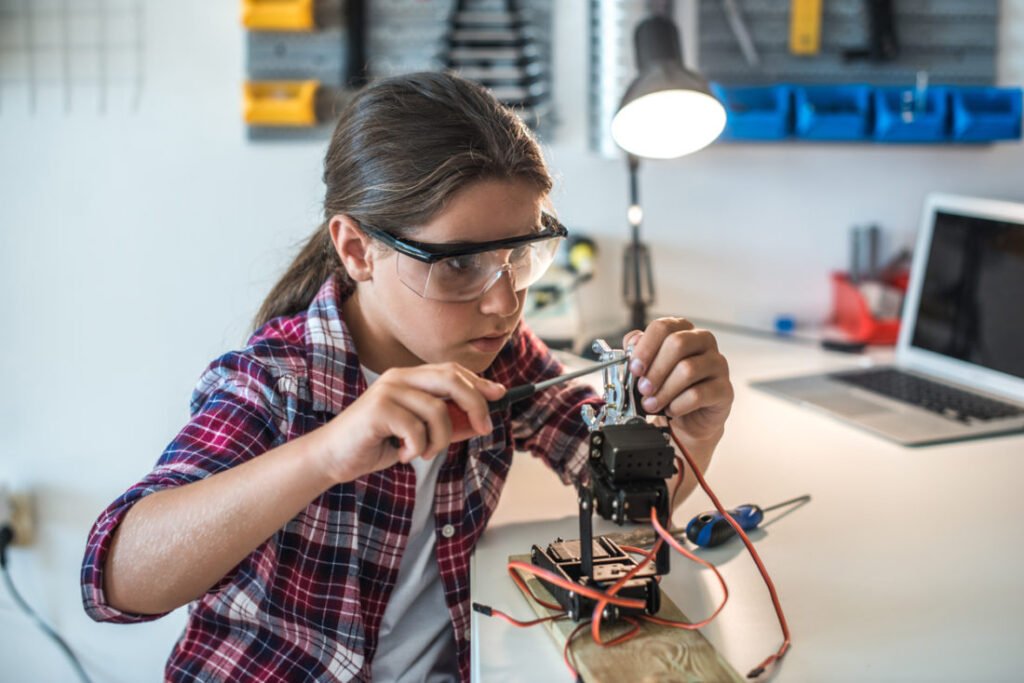n today’s technology-driven world, fostering creativity and innovation from a young age is crucial. Educational robotics is emerging as a powerful tool to engage preschoolers, sparking their curiosity and laying the foundation for future learning. This blog post explores the benefits of introducing robotics to preschoolers, the best robotics kits for young learners, and tips for implementing robotics education effectively.
The Benefits of Robotics for Preschoolers
1. Enhances Problem-Solving Skills
Robotics encourages children to think critically and solve problems. When preschoolers build and program robots, they encounter challenges requiring logical thinking and creativity. This hands-on experience helps them develop valuable problem-solving skills throughout their education and beyond.
2. Promotes Creativity and Innovation
Robotics provides a platform for creative expression. Preschoolers can design and build their robots, experimenting with different shapes, colors, and functions. This creative freedom nurtures innovation, allowing young minds to explore and bring their imaginative ideas to life.
3. Introduces STEM Concepts
Introducing robotics at an early age familiarizes children with basic STEM (Science, Technology, Engineering, and Mathematics) concepts. Through play and experimentation, preschoolers learn about mechanics, sensors, and simple programming. These early experiences can spark a lasting interest in STEM fields, preparing them for future academic success.
4. Encourages Teamwork and Collaboration
Many robotics activities are designed to be collaborative, requiring children to work together to build and program their robots. This fosters teamwork and communication skills, as preschoolers learn to share ideas, listen to others, and work towards a common goal. These social skills are crucial for their overall development.
5. Boosts Confidence and Resilience
Successfully building and programming a robot can be a significant confidence booster for young children. They experience the satisfaction of seeing their creations come to life, which encourages a growth mindset and resilience. Overcoming obstacles during the process teaches them perseverance and the value of effort.
Top Robotics Kits for Preschoolers
1. LEGO DUPLO Coding Express
LEGO DUPLO Coding Express is a fantastic introduction to robotics for preschoolers. This set combines the creativity of LEGO building with basic coding concepts. Children can build a train and use color-coded action bricks to control its movement, teaching them sequencing and logical thinking in a fun and engaging way.
2. Botley the Coding Robot
Botley the Coding Robot is designed specifically for young children, making it an excellent choice for preschoolers. It introduces basic coding without the need for screens. Using a simple remote, children can program Botley to follow commands, navigate obstacle courses, and solve puzzles, all while developing critical thinking skills.
3. Fisher-Price Think & Learn Code-a-pillar
The Code-a-pillar is an interactive toy that introduces preschoolers to sequencing and problem-solving. Children can arrange and connect segments to create different movement patterns for the Code-a-pillar, learning cause and effect. Its colorful design and engaging activities make it a hit with young learners.
4. Cubetto Playset
The Cubetto Playset is a screen-free coding toy that teaches preschoolers the basics of computer programming. Children guide a wooden robot named Cubetto through various adventures by placing coding blocks on a control board. This tactile approach to coding is intuitive and helps develop spatial awareness and logic.
Tips for Implementing Robotics Education
1. Start with Simple Concepts
Begin with basic concepts and gradually introduce more complex ideas. Preschoolers thrive with hands-on learning, so ensure activities are age-appropriate and engaging.
2. Encourage Exploration and Experimentation
Allow children to explore and experiment with the robotics kits. Give them the freedom to make mistakes and learn from them, fostering a sense of discovery and innovation.
3. Integrate Storytelling
Incorporate storytelling into robotics activities. Create narratives around the robots and their tasks, making the learning experience more relatable and exciting for preschoolers.
4. Provide Guidance and Support
While it’s essential to let children explore, provide guidance and support when needed. Be present to answer questions, offer encouragement, and help troubleshoot any challenges they encounter.
5. Foster a Collaborative Environment
Encourage teamwork and collaboration. Organize group activities where children can work together to build and program robots, promoting social skills and cooperation.
Conclusion
Genius builders are born when curiosity meets opportunity. Educational robotics for preschoolers opens up a world of learning, creativity, and innovation. By introducing young children to robotics, we can inspire a new generation of thinkers, problem-solvers, and creators. Equip your preschooler with the tools to explore and build their future, one robot at a time.

